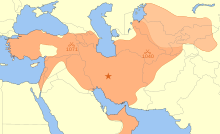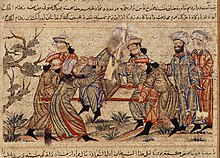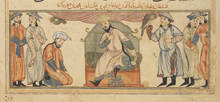List of leaders of the Nizari–Seljuk conflicts
List of the commanders and leaders of the Nizari–Seljuk conflicts
Participants[edit]

The conflicts were more complex than a simple Nizari vs Seljuk one. Even the Ismailis themselves were not unified; e.g. the Ismailis in Isfahan did not recognize the authority of Hassan-i Sabbah in Alamut. Sometimes the actual anti-Ismailism came from the local Sunni population rather than the Seljuk government, such as the massacre of the Ismailis in Isfahan in 1101. In the Seljuk dynastic conflicts, all sides were relying on Ismaili soldiers, and some Seljuk elites are known to be Ismaili converts (e.g. Iranshah ibn Turanshah) or at least to have Nizari sympathies at times (e.g. Barkiyaruq and Ridwan ibn Tutush).[1]
Nizari Ismailis[edit]

Unlike the Fatimids who mostly produced learned scholars, the Nizaris of Alamut were mostly preoccupied with survival in their extremely hostile environment, and naturally produced, or acquired the alliance of, good military leaders. Many of these commanders are both military leaders and religious preachers (da'i) at the same time.[2]
 Abd al-Malik ibn Attash,[3] Fatimid Chief Da'i of Persia and Iraq (1070s)
Abd al-Malik ibn Attash,[3] Fatimid Chief Da'i of Persia and Iraq (1070s)
- Hassan-i Sabbah, Da'i of Daylam
- Tahir
 ,[4] local leader in Sawa[5]
,[4] local leader in Sawa[5]
 Hassan-i Sabbah, hujja, Lord of Alamut (1090–1124)
Hassan-i Sabbah, hujja, Lord of Alamut (1090–1124)
- Dihdar Abu Ali Ardestani,[6] da'i in Qazwin
- Husayn Qa'ini,[7] da'i, muhtasham (Governor) of Quhistan[8]
- Kiya Muzaffar?,[9] muhtasham of Quhistan[10]
- al-Hakim al-Munajjim, Chief Da'i of Syria
- Abu Tahir al-Sa'igh
 , Chief Da'i of Syria
, Chief Da'i of Syria
- Abu al-Fath of Sarmin
 , da'i in Syria
, da'i in Syria - Husam al-Din ibn Dumlaj,[11] commander of the Nizari armed forces in Aleppo
- Ibrahim al-Ajami,[12] commandant of the Qal'at al-Balis
- Isma'il
 ,[13] da'i
,[13] da'i - Unnamed brother of al-Hakim al-Munajjim

- Abu al-Fath of Sarmin
- Bahram al-Da'i, Chief Da'i of Syria
- Mu'ayyad al-Din Muzaffar ibn Ahmad Mustawfi,[14] former Seljuk ra'is, commandant of Gerdkuh[15][16][17]
- Abu Hamza,[18] da'i in Arrajan[19]
- Kiya Buzurg-Ummid, commander, commandant of Lambsar Castle
- Kiya Abu Ja'far,[20] commander[21]
- Kiya Abu Ali,[22] commander[21]
- Kiya Garshasb,[23] commander[21]
- Hasan Adam Qasrani
- Kayqubad Daylami,[24] commandant of Tikrit Citadel[25]
 Ahmad ibn Abd al-Malik ibn Attash
Ahmad ibn Abd al-Malik ibn Attash  ,[26] da'i[27]
,[26] da'i[27] Kiya Buzurg-Ummid, hujja, Lord of Alamut (1124–1138)
Kiya Buzurg-Ummid, hujja, Lord of Alamut (1124–1138)
- Dihdar Abu Ali Ardestani, member of the ruling council
- Hasan Adam Qasrani, member of the ruling council
- Kiya Abu Ja'far, member of the ruling council
- Isma'il al-Ajami, Chief Da'i of Syria
- Salarjuy(?), defected Seljuk amir[28]
- Kiya Nushad(?), commander[28]
- Khwaja Muhammad Nasihi Shahrastani
 [29]
[29]
 Kiya Muhammad ibn Buzurg-Ummid, hujja, Lord of Alamut (1138–1162)
Kiya Muhammad ibn Buzurg-Ummid, hujja, Lord of Alamut (1138–1162)
- Kiya Muhammad ibn Ali Khusraw Firuz,[30] commander[31]
- Kiya Ali ibn Buzurg-Ummid,[32] commander[31]
- Dihkhuda Abu Yusuf, commander[10]
- Kiya Husayn ibn Abd al-Jabbar[10]
- Amir Balqasim Shamshirzan (POW)
 , commander in Lambsar[10]
, commander in Lambsar[10] - Amir Malikshah, commander[10]
- Kiya Isma'il, commander[10]
- Ali ibn Wafa' †,[33] commander in Syria
- Shaykh Abu Muhammad, Chief Da'i of Syria

 Hassan II 'Ala Dhikrihi's-Salam, Imam, Lord of Alamut (1162–1166)
Hassan II 'Ala Dhikrihi's-Salam, Imam, Lord of Alamut (1162–1166)
- Rashid al-Din Sinan, Chief Da'i of Syria
 Nur al-Din Muhammad II, Imam, Lord of Alamut (1166–1210)
Nur al-Din Muhammad II, Imam, Lord of Alamut (1166–1210)
Allies and sympathizers[edit]
 Barkiyaruq (occasionally), sultan
Barkiyaruq (occasionally), sultan
- Majd al-Mulk al-Balasani
 ,[34] vizier of Barkiyaruq[25]
,[34] vizier of Barkiyaruq[25]  Amirdad Habashi,[35] amir of Barkiyaruq,[16] commander of Tabaristan and Jurjan[36]
Amirdad Habashi,[35] amir of Barkiyaruq,[16] commander of Tabaristan and Jurjan[36]
- Majd al-Mulk al-Balasani
- Sa'd al-Mulk
 , vizier of Muhammad Tapar[37]
, vizier of Muhammad Tapar[37] - Abu al-Qasim Dargazini, vizier of Mahmud II
- Iranshah ibn Turanshah, sultan of the Seljuks of Kirman[19]
 Sanjar, ruler of Khurasan (1097–1118), sultan of the Great Seljuk Empire (1118–1153)
Sanjar, ruler of Khurasan (1097–1118), sultan of the Great Seljuk Empire (1118–1153)- Fakhr al-Mulk Ridwan ibn Tutush, sultan of Aleppo
- Shams al-Mulk Alp Arslan al-Akhras (until 1113), sultan of Aleppo
- Ilghazi, amir, Artuqid prince of Mardin and Mayyafariqin
- Toghtekin, atabeg of Damascus
- Shahrnush ibn Hazarasf ibn Namawar, Bawandid ruler
- Hazarasf ibn Shahrnush (d. 1190), Paduspanid ruler[40]
 Raymond of Poitiers †, Prince of Antioch
Raymond of Poitiers †, Prince of Antioch Al-Amid ibn Mansur (Mas'ud?),[41] governor of Turaythith[42]
Al-Amid ibn Mansur (Mas'ud?),[41] governor of Turaythith[42]- Many others*[43]
Nizari enemies[edit]
Great Seljuk Empire[edit]

 Malikshah I, sultan of the Great Seljuk Empire (1072–1092)
Malikshah I, sultan of the Great Seljuk Empire (1072–1092)
 Barkiyaruq, sultan of the Great Seljuk Empire (1094–1105)
Barkiyaruq, sultan of the Great Seljuk Empire (1094–1105)
- Abd al-Rahman al-Simirumi X, vizier
- Abd al-Jalil Abu al-Fath Durdanah al-Dihistani X (DOW), vizier[10]
- Fakhr al-Mulk ibn Nizam al-Mulk X, vizier
 Sanjar, ruler of Khurasan (1097–1118)
Sanjar, ruler of Khurasan (1097–1118)
- Bursuq the Elder X, amir ispahsalar, governor of Luristan, atabeg of Sanjar, shihna of Khurasan
 Ahmad ibn Muhammad al-Labbad X, governor of Isfahan
Ahmad ibn Muhammad al-Labbad X, governor of Isfahan Abu Muslim X, ra'is (prefect) of Rayy
Abu Muslim X, ra'is (prefect) of Rayy Anushtagin,[52] amir[21]
Anushtagin,[52] amir[21] Unar Malikshahi X, amir sipahdar[10]
Unar Malikshahi X, amir sipahdar[10] Siyah(push?) X, amir[10]
Siyah(push?) X, amir[10] Arghush al-Nizami X, amir sipahdar, mamluk of Nizam al-Mulk[10]
Arghush al-Nizami X, amir sipahdar, mamluk of Nizam al-Mulk[10]
 Sarzan Malikshahi X, amir sipahsalar[10]
Sarzan Malikshahi X, amir sipahsalar[10] Sunqurcha X, wali of Dihistan[10]
Sunqurcha X, wali of Dihistan[10] Sultan al-Ulama' Abu al-Qasim Asfazari X, ra'is of Bayhaq[10]
Sultan al-Ulama' Abu al-Qasim Asfazari X, ra'is of Bayhaq[10]- Abd al-Rahman Qazwini X[10]
- Abu Muhammad Za'farani,[53] Hanafi scholar, military leader[21]
- Iskandar Sufi Qazwini X,[54] mufti[21]
- Abdullah Isfahani X, qadi[10]
- Muntahi Alawi X, mufti of Jurjan[10]

 Muhammad Tapar, sultan of the Great Seljuk Empire (1105–1118)
Muhammad Tapar, sultan of the Great Seljuk Empire (1105–1118)
 Sanjar, ruler of Khurasan (1097–1118)
Sanjar, ruler of Khurasan (1097–1118) Fakhr al-Dawla Chawli,[55] atabeg of Fars[56]
Fakhr al-Dawla Chawli,[55] atabeg of Fars[56] Anushtagin Shirgir,[57] atabeg, governor of Sawa
Anushtagin Shirgir,[57] atabeg, governor of Sawa Mawdud ibn Altuntash X, amir ispahsalar, atabeg of Mosul, governor of Diyar Bakr and the Levant[58][59]
Mawdud ibn Altuntash X, amir ispahsalar, atabeg of Mosul, governor of Diyar Bakr and the Levant[58][59] Aqsunqur al-Bursuqi X, atabeg of Mosul[60][61]
Aqsunqur al-Bursuqi X, atabeg of Mosul[60][61]- Ahmad ibn Nizam al-Mulk (WIA), vizier
 Ahmadil ibn Ibrahim al-Kurdi X, amir of Maragha[62]
Ahmadil ibn Ibrahim al-Kurdi X, amir of Maragha[62] Balakabak Sarmuz X, senior amir[63][10]
Balakabak Sarmuz X, senior amir[63][10]- Abu 'Amid X, mustawfi (accountant) of Rayy
- Abu al-Muzaffar al-Khujandi X, chief preacher in Rayy, mufti[63][10]
- Abu Ja'far Mashshati Razi X, mufti of Rayy[10]
 Abu al-Hasan X, ra'is of Bayhaq[10]
Abu al-Hasan X, ra'is of Bayhaq[10]- Ubayd Allah ibn Ali al-Khatibi X, qadi of Isfahan
- Sa'id ibn Muhammad ibn Abd al-Rahman X, qadi of Nishapur
- Abu al-Ala' X, mufti in Isfahan[10]

 Sanjar, nominal head of the Seljuq dynasty (1118–1153) (the Supreme Sultan; al-sultan al-a'zam)[64]
Sanjar, nominal head of the Seljuq dynasty (1118–1153) (the Supreme Sultan; al-sultan al-a'zam)[64]
- Mu'in al-Mulk Abu Nasr ibn Fazl X, vizier
- Mu'in al-Din al-Kashi X, vizier
- Yamin al-Dawla Khwarazmshah X, vizier, prince of the Khwarazmian dynasty
 Bazghash,[65] amir[27]
Bazghash,[65] amir[27] Qajaq,[66] amir[42]
Qajaq,[66] amir[42] Muhammad ibn Anaz,[67] amir[42]
Muhammad ibn Anaz,[67] amir[42] Ala al-Din Mahmud,[68] governor of Turaythith[42]
Ala al-Din Mahmud,[68] governor of Turaythith[42] Aqsunqur X, mamluk, governor of Turshiz (killed while rebelling against the sultan)[10][63]
Aqsunqur X, mamluk, governor of Turshiz (killed while rebelling against the sultan)[10][63]- ? X, qadi of Quhistan
 Tughrul Mahalli X, wali of Damghan[10]
Tughrul Mahalli X, wali of Damghan[10]

 Mahmud II, sultan of the Seljuks of Iraq (1118–1131)
Mahmud II, sultan of the Seljuks of Iraq (1118–1131)
- Kamal al-Mulk Abu Talib al-Simirumi X, vizier
 Tamurtughan (POW),[69] amir[70][10]
Tamurtughan (POW),[69] amir[70][10] Yaran-Qush Bazdar
Yaran-Qush Bazdar  ,[71] amir of Qazwin[10]
,[71] amir of Qazwin[10] Unar X, amir of Khurasan[10]
Unar X, amir of Khurasan[10] Asil,[72] commander
Asil,[72] commander Unnamed Turkic amir in Qazwin †[10]
Unnamed Turkic amir in Qazwin †[10] Unnamed sons of Yaran-Qush Bazdar[10]
Unnamed sons of Yaran-Qush Bazdar[10] Qimaz(?) Harami, commander[10]
Qimaz(?) Harami, commander[10] Sunqur Inanj, wali of Rayy[10]
Sunqur Inanj, wali of Rayy[10]- Abu Nasr Muhammad ibn Nasr ibn Mansur al-Harawi X, Hanafi qadi of Hamadan[10][63]
- Abd al-Latif al-Khujandi X, Shafi'i leader in Isfahan[63][10]
 Da'ud X, sultan of the Seljuks of Iraq (1131–1132)
Da'ud X, sultan of the Seljuks of Iraq (1131–1132) Tughril II, sultan of the Seljuks of Iraq (1132–1135)
Tughril II, sultan of the Seljuks of Iraq (1132–1135)
- ? X, vizier
 Mas'ud, sultan of the Seljuks of Iraq (1135–1152)
Mas'ud, sultan of the Seljuks of Iraq (1135–1152)
 Abbas X, amir, shihna (governor) of Rayy[10]
Abbas X, amir, shihna (governor) of Rayy[10]
- Jawhar X, chamberlain
 Dawlatshah Alawi X, prefect of Isfahan
Dawlatshah Alawi X, prefect of Isfahan Aqsunqur Ahmadili X, atabeg of Maragha
Aqsunqur Ahmadili X, atabeg of Maragha Shams Tabrizi X, ra'is (prefect) of Tabriz[10]
Shams Tabrizi X, ra'is (prefect) of Tabriz[10]- Hasan ibn Abi al-Qasim Karkhi X, mufti of Qazwin
 Qutlugh, wali of Qazwin[10]
Qutlugh, wali of Qazwin[10] Aqsunqur Firuzkuhi, wali of Rayy[10]
Aqsunqur Firuzkuhi, wali of Rayy[10] Khumar-Tash, commander[10]
Khumar-Tash, commander[10]- Unnamed qadi of Tiflis X
- Unnamed qadi of Hamadan X
 Muhammad II ibn Mahmud, sultan
Muhammad II ibn Mahmud, sultan Balak Ghazi, amir, (nominal) governor of Aleppo
Balak Ghazi, amir, (nominal) governor of Aleppo- Ibn al-Khashshab X, qadi and ra'is of Aleppo, de facto ruler of Aleppo since 1113
 Nur al-Din Mahmud, Zengid amir of Damascus and Aleppo
Nur al-Din Mahmud, Zengid amir of Damascus and Aleppo Janah al-Dawla X, amir of Homs
Janah al-Dawla X, amir of Homs- Shams al-Mulk Alp Arslan al-Akhras (since 1113), sultan of Aleppo
- Taj al-Muluk Buri X (DOW), Burid atabeg of Damascus
- Nasir al-Dawla ibn al-Muhalhil X, vizier
 Garashasaf X, wāli of Kirman
Garashasaf X, wāli of Kirman
Abbasid Caliphate[edit]

 al-Mustazhir, caliph
al-Mustazhir, caliph al-Mustarshid X, caliph
al-Mustarshid X, caliph al-Rashid X, caliph
al-Rashid X, caliph al-Mustadi, caliph
al-Mustadi, caliph
Fatimid Caliphate[edit]


 al-Afdal Shahanshah X, vizier
al-Afdal Shahanshah X, vizier al-Musta'li, Caliph-Imam
al-Musta'li, Caliph-Imam al-Amir bi-Ahkam Allah X, Caliph-Imam
al-Amir bi-Ahkam Allah X, Caliph-Imam
- al-Ma'mun al-Bata'ihi, vizier
- Khalaf ibn Mula'ib X, semi-independent amir of Homs and Apamea[77]
- Mus'ab ibn Mula'ib,[78] commander[77]
Ayyubid Sultanate[edit]
 Saladin, sultan of Syria and Egypt
Saladin, sultan of Syria and Egypt
Crusaders[edit]

 Baldwin II, King of Jerusalem
Baldwin II, King of Jerusalem Conrad I X, King of Jerusalem (de facto)
Conrad I X, King of Jerusalem (de facto) Amalric, King of Jerusalem
Amalric, King of Jerusalem
 Raymond II X, Count of Tripoli
Raymond II X, Count of Tripoli
- Ralph of Merle X, knight
- Unnamed lieutenant X
 Odo de St Amand, Grand Master (1171–1179)
Odo de St Amand, Grand Master (1171–1179)
- Du Mesnil, knight[79]
- Raymond du Puy, Grand Master
- Gilbert of Assailly, Grand Master
- Roger de Moulins, Grand Master
- Guérin de Montaigu, Grand Master
Other (semi)-independent leaders[edit]
 Mahdi (POW),[80] Zaydi commandant of Alamut Castle[8]
Mahdi (POW),[80] Zaydi commandant of Alamut Castle[8]- Baha' al-Dawla of Sistan
- Rasamuj,[81] commandant of Lambsar Castle
- Shah Ghazi Rustam, Bawandid ruler of Mazandaran and Gilan[82]
- Girdbazu X, King of Mazandaran[82]
- Kayka'us, Paduspanid ruler (d. 1164/1165)[40]
 Abu Hashim Alawi (POW)
Abu Hashim Alawi (POW)  , Zaydi Imam[83]
, Zaydi Imam[83] Hadi Kiya ibn Abi Hashim X, Zaydi Imam[10]
Hadi Kiya ibn Abi Hashim X, Zaydi Imam[10]- Mahmashad X, Karramiyya leader[10]
- Garshasaf †, amir, ruler in Georgia[10][63]
See also[edit]
References[edit]
- ^ Peacock, A. C. S. (2015). Great Seljuk Empire. Edinburgh University Press. p. 75. ISBN 978-0-7486-9807-3.
- ^ Daftary, Farhad (22 February 2001). Mediaeval Isma'ili History and Thought. Cambridge University Press. pp. 5–6. ISBN 978-0-521-00310-0.
- ^ عبدالملک بن عطاش
- ^ طاهر
- ^ Lewis, Bernard (2011). The Assassins: A Radical Sect in Islam. Orion. pp. 53–. ISBN 978-0-297-86333-5.
- ^ دهدار ابو علی اردستانی
- ^ حسین قائنی
- ^ a b Daftary 2007, pp. 314–316
- ^ کیا مظفر
- ^ a b c d e f g h i j k l m n o p q r s t u v w x y z aa ab ac ad ae af ag ah ai aj ak al am an ao رشیدالدین فضلالله همدانی 1381.
- ^ حسام الدين بن دملاج
- ^ إبراهيم العجمي
- ^ داعی اسماعیل
- ^ مؤیدالدین مظفر بن احمد مستوفی
- ^ Succeeded as Girdkuh's commandant by his son Sharaf al-Din Muhammad (شرف الدین محمد) after "a long time".
- ^ a b Daftary 2007, pp. 320–321
- ^ Daftary, Farhad. "GERDKŪH – Encyclopaedia Iranica". www.iranicaonline.org. Retrieved 1 April 2020.
- ^ ابو حمزه
- ^ a b Daftary 2007, p. 321
- ^ کیا ابو جعفر
- ^ a b c d e f Daftary 2007, p. 324
- ^ کیا ابو علی
- ^ کیا گرشاسب
- ^ کیقباد دیلمی
- ^ a b Daftary 2007, pp. 321–324
- ^ احمد بن عبدالملک بن عطاش
- ^ a b Daftary 2007, pp. 329–330
- ^ a b روشن 1387, p. 111
- ^ خواجه محمد ناصحی شهرستانی
- ^ کیا محمد بن علی خسرو فیروز
- ^ a b Daftary 2007, pp. 355–356
- ^ کیا علی بن بزرگ امید
- ^ علي بن وفاء
- ^ مجدالملک البلاسانی
- ^ امیرداد حبشی
- ^ Osman Aziz Basan, p.184
- ^ Osman Aziz Basan, p.196
- ^ أبو علي طاهر بن سعد المزدقاني
- ^ a b c Mirza, Nasseh Ahmad (1997). Syrian Ismailism: The Ever Living Line of the Imamate, AD 1100-1260. Psychology Press. p. 12. ISBN 978-0-7007-0505-4.
- ^ a b Daftary 2007, p. 344
- ^ العمید بن منصور (مسعود؟)
- ^ a b c d Daftary 2007, p. 357
- ^ The Nizaris often infiltrated into the Seljuk military; Symposium, Comité international d'études pré-ottomanes et ottomanes (1998). Essays on Ottoman civilization. Academy of Sciences of the Czech Republic, Oriental Institute. p. 176.
- ^ ابو مسلم
- ^ Daftary 2007, p. 314
- ^ امیر یورنتاش. Misspelled as Turun-Tash. In Turkish: Yorun-Tash
- ^ Daftary 2007, p. 318
- ^ Basan, Osman Aziz (24 June 2010). The Great Seljuqs: A History. ISBN 9781136953927.
- ^ امیر ارسلان تاش
- ^ a b Daftary 2007, p. 319
- ^ امیر قزل سارغ
- ^ انوشتگین
- ^ ابو محمد زعفرانی
- ^ اسکندر صوفی قزوینی
- ^ فخرالدوله چاولی
- ^ Daftary 2007, p. 337
- ^ انوشتگین شیرگیر
- ^ Mirza, Nasseh Ahmad (1997). Syrian Ismailism: The Ever Living Line of the Imamate, AD 1100-1260. Psychology Press. pp. 8–12. ISBN 9780700705054.
- ^ Daftary 2007, p. 334
- ^ Gibb, N. A. R., Editor (1932), The Damascus Chronicle of the Crusades. Extracted and translated from the Chronicle of ibn al-Qalānisi, Luzac & Company, London, pp.174-177, 179-180, 187-191
- ^ Daftary 2007, p. 349
- ^ رازنهان, محمدحسن; خلیلی, مهدی. "تحلیلی بر روابط سیاسی اسماعیلیان نزاری با خلافت عباسی" (PDF). نشریه مطالعات تقریبی مذاهب اسلامی (فروغ وحدت) (in Persian) (32): 26. ISSN 2252-0678.
- ^ a b c d e f Cook, David (1 January 2012). "Were the Ismāʿīlī Assassins the First Suicide Attackers? An Examination of Their Recorded Assassinations". The Lineaments of Islam: 97–117. doi:10.1163/9789004231948_007. ISBN 9789004218857.
- ^ Hanne, Eric J. (2007). Putting the Caliph in His Place: Power, Authority, and the Late Abbasid Caliphate. Fairleigh Dickinson Univ Press. p. 142. ISBN 978-0-8386-4113-2.
- ^ بزغش
- ^ امیر قجق
- ^ محمد بن انز
- ^ علاءالدین محمود
- ^ طمورطغان or تمور طغان (Temur Tughan) or تمور طغیان (Temur Tughyan)
- ^ Daftary 2007, p. 345
- ^ یرنقش بازدار
- ^ اصیل
- ^ صاعد بن بديع
- ^ مفرج بن الحسن بن الصوفي
- ^ يوسف بن فيروز
- ^ Daftary 2007, pp. 347–348
- ^ a b c Daftary 2007, pp. 333–334
- ^ مصعب بن ملاعب
- ^ Porter, Whitworth (1858). A History of the Knights of Malta: Or The Order of the Hospital of St. John of Jerusalem. Longman, Brown, Green, Longmans, & Roberts. p. 92.
- ^ مهدی
- ^ رساموج
- ^ a b Daftary 2007, pp. 344–345
- ^ Daftary 2007, p. 346
Sources[edit]
- Daftary, Farhad (2007). The Ismāʿı̄lı̄s: Their History and Doctrines (Second ed.). Cambridge: Cambridge University Press. ISBN 978-0-521-61636-2.
- روشن, محمد (1387). جامع التواریخ (تاریخ اسماعیلیان). مرکز پژوهشی میراث مکتوب.
- رشیدالدین فضلالله همدانی (1381). دانش پژوه, محمدتقی; مدرسی زنجانی, محمد (eds.). جامع التواریخ: اسماعیلیان و فاطمیان. تهران: انتشارات علمی و فرهنگی.
